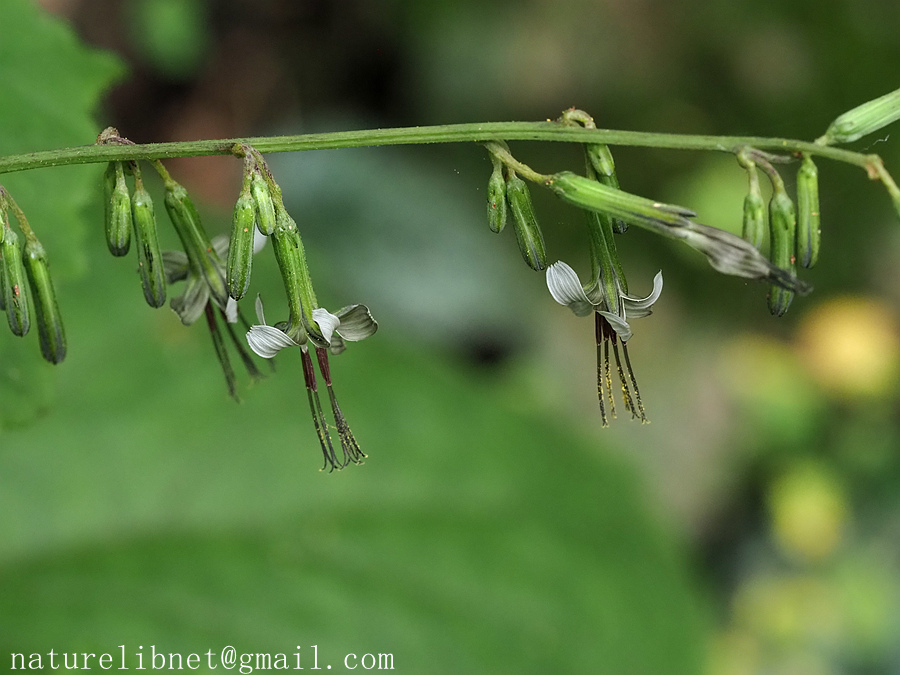- Scientific Name: Nabalus tatarinowii (Maximowicz) Nakai
- Ref: Fl. Sylv. Kor. 14: 116. 1923.
- Synonyms:
Prenanthes tatarinowii Maximowicz, Mém. Acad. Imp. Sci. St.-Pétersbourg Divers Savans 9: 474. 1859;
Lactuca tatarinowii (Maximowicz) Franchet;
Nabalus pyramidalis (C. Shih) Sennikov;
N. racemiformis (C. Shih) Sennikov;
P. pyramidalis C. Shih;
P. racemiformis C. Shih.
- Chinese Common Name:盘果菊 pan guo ju
- Family: Asteraceae
- Genus: Nabalus
- Distribution: Mountain slopes, forest margins, forests, grasslands, moist places by water; 500-3000 m. Gansu, Hebei, Heilongjiang, Henan, Hubei, Jilin, Liaoning, Nei Mongol, Ningxia, Shaanxi, Shandong, Shanxi, Sichuan, Yunnan [Korea, SE Russia].
- Type: Prenanthes tatarinowii, Hab. in declivibus montium a Pekino(北京) septentrionem versus, prope templum Tschshan-chanj, floret Augusto(Dr. Tatarinow legit)
- Note: 2002 New record in Zhejiang: Mt. Longtang
Herbs 0.5-2 mm tall, perennial. Stem solitary, erect, virgately branched usually in upper half, glabrous or subglabrous. Lower and middle stem leaves sparsely pilose with fine multicellular hairs and hispidulous with stiff subulate hairs; petiole 7-17 cm. Leaf blade of lower and middle stem leaves for subsp. tatarinowii either ovate to triangular-ovate, 5-15 × 6-15 cm, undivided, base cordate, hastate, truncate, or cuneate, margin subentire to sinuate-dentate with mucronate teeth, and apex acute to acuminate or leaf blade additionally with 1 pair of elliptic to obliquely ovate lateral lobes 0.6-5.5 × 0.4-4.5 cm. Leaf blade of lower and middle stem leaves for subsp. macrantha to 29 × 22 cm and divided; lateral lobes 1-3 pairs, elliptic, ovate, or lanceolate, much smaller than terminal lobe, margin subentire to coarsely sinuate-dentate with mucronate teeth, apex acute; terminal lobe broadly triangular-ovate, suborbicular, or broadly lanceolate in outline, pinnatipartite to pinnatisect with segments lanceolate, elliptic, or oblanceolate, base cordate to cuneate, margin coarsely sinuate-dentate with mucronate teeth, apex acute to acuminate. Upper and uppermost stem leaves similar to middle stem leaves in division but smaller and broadly triangular-ovate, linear-lanceolate, subrhombic, broadly ovate, or ovate, base truncate to cuneate, apex shortly to long acuminate. Synflorescence paniculiform, with some to many capitula. Capitula pendent at anthesis, erect in fruit, with ca. 5 florets; peduncle capillaceous, shorter than involucre, often densely pilose with multicellular hairs. Involucre narrowly cylindric, 10-13 × 1.5-2.5 mm. Outer phyllaries few, ovate to triangular-ovate, longest 2-3 mm, apex acute to obtuse; inner phyllaries 5, linear-lanceolate to linear, ± with scarious margin abaxially often sparsely pilose, apex obtuse to rounded. Florets pale purple, pink, whitish, or greenish. Anther tube brownish purple. Achene brown, 3.5-4.5 mm, apex truncate. Pappus brown to brick-colored, 6-8 mm.(Flora of China)
